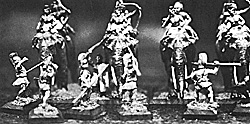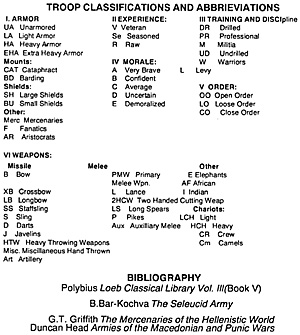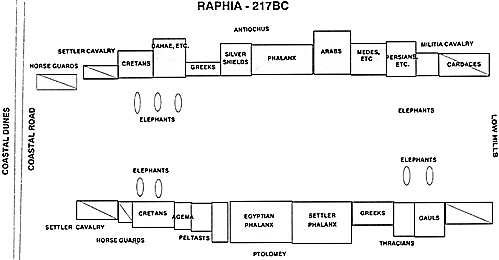 The battle of Raphia occurred in 217 B.C. between two of the SuccessorEmpires of Alexander the Great. The Seleucid Empire under Antiochus III (the Great) fought the Egyptian Empire of Ptolomey IV for control of Coele-Syria or southern Palestine. This region had long been in dispute between the two empires.
The battle of Raphia occurred in 217 B.C. between two of the SuccessorEmpires of Alexander the Great. The Seleucid Empire under Antiochus III (the Great) fought the Egyptian Empire of Ptolomey IV for control of Coele-Syria or southern Palestine. This region had long been in dispute between the two empires.
The Egyptian forces had apparently been in a period of neglect, and priorto this battle Ptolomey was forced to take major efforts to reorganize and strengthen his army. This included arming and training 20,000 native Egyptians as phalangites, acquiring and training African elephants, and hiring new mercenaries. Antiochus on the other hand was fresh from victory over an usurper to his throne (Molon).
The two armies met along the coastal road near Gaza. The terrain was flat with low hills on one flank and sandy coastal dunes along the other. The road ran along this later flank. The composition of the two forces is described below and their disposition is indicated on the map. Antiochus was seriously outnumbered in phalangites (unless you accept the theory of G.T. Griffith which argues that the total Ptolemaic phalanx was only 25000). The Egyptian Phalanx, however, was untested and Antiochus did have the edge in cavalry and elephants. His auxiliaries were somewhat suspect.
The actual battle is well described in Polybius (see map of disposition). Antiochus' Indian elephants beat the outnumbered and smaller African elephants pushing them back on the infantry (including Ptolomey's foot guardswho were routed with the aid of Antiochus' Greek Mercenaries. Antiochus' right wing cavalry including his Guard, beat the opposing Ptolemaic cavalry and pursued it. Ptolomey then shifted to his phalanx. On the other wing the Ptolomaic mercenary cavalry defeated the Seleucid horse and Ptolomey's Greek mercenaries routed the Arabs and Medes. The two phalanxes then charged and Antiochus' outnumbered phalangites lost. Antiochus returned from pursuit too late. Losses, particularly among the infantry, were heavyfor Antiochus.
The battle is fairly straight forward and easy to fight as a wargame. While I normally like to do refights on a scale of 100: 1, this one was done usinga scale of 200:1 /(Elephants 20:1) because of the large numbers of certain troops (painting 50 Arabs was bad enough let alone 100). The rules used were my own evolving house rules. We fought the battle on two separate occasions. The first time with five players and the second time with six. In neither case was anyone other than myself overly familiar with the rules, although most had played with them once or twice. In any event the results seemed very reasonable and the games were played to a complete conclusion in less than 3 hours.
The first game was very much like the actual battle with Antiochus being victorious on his flank, but after pursuit being unable to influence the outcome. The Ptolemaic foot guards and peltasts did better against their Seleucid Greek mercenary opponents. The Ptolemaic right wing crushed the Seleucid left flank and the huge Ptolemaic phalanx rolled over the Seleucid phalanx, the Silver Shields holding out somewhat longer.
The second battle was the more interesting, or perhaps my memory is just better. The heavy cavalry combat on the Seleucid right flank seesawed back and forth and was essentially a draw, although Polycrates was killed early on. The Seleucid elephants on this flank routed their counterparts (one stampeded due to missile fire) and in turn proceeded to route the PtolemaicRoyal Foot Guards. The Cretan archers of both sides continued to slug it out (via missile fire). The Lybian phalanx was pushed back by the Seleucid peltasts whereas part of the Ptolemaic phalanx routed the Seleucid heavy peltasts the Ptolemaic peltasts then to break the Seleucid peltasts.

On the Seleucid left wing one Ptolemaic elephant stampeded back into the Gauls who eventually killed it but were delayed in the process. The other African elephant was broken by the Seleucid elephants who went on to rout the Ptolemaic cavalry. The Thracians, Greeks and some of Ptolomy's phalangites routed the Arabs and Medes. Meanwhile the Seleucid cavalry broke the Gauls.
In the center the Seleucid phalanx advanced more aggressively than in the previous game. The Seleucid settler phalanx pushed back and broke the Egyptian phalanx and part of the Ptolemaic phalanx. The Argyraspides had a tougher go against the remaining phalangites units but eventually broke them as well. The Seleucid left wing had been soundly defeated, while their center was victorious, and the right wing was basically a draw. The remaining units were too scattered, weakened, or involved in pursuit to make any difference in the outcome. In all, the battles were great fun and went fast considering over 700 figures were involved. Playing an historical battle can give some real insight into a period, and into your rules. Likewise the actual army compositions cause one to reflect on their 1500 point army list derivatives (Also note that there were no woods or rough terrain for all those peltast types to gravitate to). This one is fairly easy to refight. I'd be interested to hear from anyone else who tries it.
PTOLEMAIC ARMY
70,000 foot, 5,000 horse, 73 elephants
COMMANDERS
LEFT WING: Ptolomey Polycrates
CENTER: Andromachus Sosibus
RIGHT WING: Echrate
| Actual Numbers | Game Strength | Unit | Armor | Exp. | Trng. | Morale | Order | Weapons |
|---|---|---|---|---|---|---|---|---|
| 3000 | 16 | Royal Foot Guard | HA,Sh | V | Pr | A | CO | Ls |
| 2000 | 10 | Peltasts | LIA,Sh | S | Pr | C | LO | Ls |
| 3000 | 16 | Cretans (incl 1000 Neocretans) | UA | S | Pr | C (merc) | CO | B,Aux |
| 3000 | 16 | Phalanx | UA,Sh | R | M | D | CO | P,Aux |
| 25000 | 120 | Settler Phalanx (48, 48, 24) | LA,Sh | R | M | C | CO | P,Aux |
| 20000 | 100 | Egyp. Phallanx (32, 32, 36) | LA,Sh | R | M | C | CO | P,Aux |
| 8000 | 20 | Greeks* | LA,Sh | S | Pr | C (merc) | CO | LS |
| 8000 | 20 | Greeks | LA,Sh | S | Pr | C (merc) | CO | LS |
| 6000 | 12 | Thracians** | UA,Sh | S | M | G | LO | JPMW |
| 9000 | 18 | Gauls** | UA,Sh | S | W | B | LO | JPMW |
| 700 | 4 | Guard Cavalry | HA,Bd | V | Pr | A | LO | L |
| 2300 | 6 | Lybian (settler) Cav *** | HA | S | M | C | LO | L |
| Egyptian (settler) Cav *** | HA | S | M | C | LO | L | ||
| 2000 | 10 | Greek/Merc Cav | LA,Sh | S | Pr | C (merc) | LO | JPMW |
| 73 | 4 | Elephants (A) (2,2) | Bd | R | M | C | - | 2 crew B,P |
*These supposedly trained with the phalanx and could be phalangites. They did not fight with the phalanx but charged ahead and routed the Arabs, etc. i treated them as mercenary hoplites. Alternatively they could be peltasts.
**Some of these were settlers and other newly hired mercenaries. I treated the Gauls as newly hired and the Thracians as settlers.
***These were presumably settler cavalry not native Egyptians and Lybians.
SELEUCID ARMY
62,000 foot, 6,000 horse, 102 elephants
COMMANDERS
LEFT WING:Themison Mysicus
CENTER:Theodotus Niarchus
RIGHT WING:Antiochus Antipater
| Actual Numbers | Game Strength | Unit | Armor | Exp. | Trng. | Morale | Order | Weapons |
|---|---|---|---|---|---|---|---|---|
| 5000 | 12 | Dahae/Carmanians | UA | S | W | C | CO | B Aux |
| 5000 | 12 | Cilicians | UA,Sh | S | W | C | CO | PMW |
| 10000 | 48 | Argyraspides (Silver Sh 16,32) | LA,Sh | V | Pr | B | CO | P,Aux |
| 20000 | 96 | Phalanx (4x24) | LA.Sh | S | Pr | C | CO | P,Aux |
| 2000 | 6 | Agrians | UA,Bu | S | M | C | CO | S,Aux |
| 2000 | 6 | Persians | UA | S | M | C | CO | B.Aux |
| 1000 | 6 | Thracians | UA,Sh | S | M | C | LO | JPMW |
| 5000 | 24 | Medes, Cissians, Cadusians, Carmaninas | UA | S | W | D | CO | B,Aux |
| 10,000 | 38 | Arabs & neighboring tribes | UA(8, Bu) | S | W | D | CO | B,S,J/Aux |
| 5000 | 12 | Arabs(subunit) | UA,Sh | S | W | D | LO | J/Aux |
| 5000 | 12 | Greeks | UA,Sh | S | Pr | C(Merc) | LO | J,LS |
| 5000 | 12 | Greeks | HA,Sh | S | Pr | C(Merc) | LO | J,LS |
| 2500 | 12 | Cretans (1,000 Neocretans) | UA | S | Pr | C(Merc) | CO | B,Aux |
| 1500 | 8 | Lydians/Cardaces | UA,Sh | S | W | C | LO | J, PMW |
| 1000 | 5 | Agema Cavalry | HA,Bd | U | Pr | A | LO | L |
| 1000 | 5 | Companion Cavalry | HA,Bd | V | Pr | A | LO | L |
| 2000 | 5 | Settler Cavalry | HA | S | Pr | C | LO | L |
| 2000 | 5 | Settler Cavalry | HA | S | Pr | C | LO | L |
| 2000 | 10 | Militia Cavalry | UA | S | M | C | CO | J,PMW |
| 102 | 5 | Elephants(l) (3,2) | Bd | S | M | C | - | 3 Crew-J,B,P |

Back to Table of Contents -- Courier #57
To Courier List of Issues
To MagWeb Master Magazine List
© Copyright 1992 by The Courier Publishing Company.
This article appears in MagWeb (Magazine Web) on the Internet World Wide Web.
Other military history articles and gaming articles are available at http://www.magweb.com